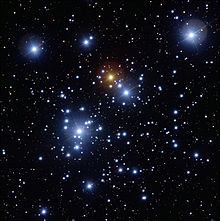DU Crucis
| Observation data Epoch J2000 Equinox J2000 | |
|---|---|
| Constellation | Crux |
| Right ascension | 12h 53m 41.33485s[1] |
| Declination | −60° 20′ 57.9647″[1] |
| Apparent magnitude (V) | 7.45[2] |
| Characteristics | |
| Spectral type | M2- Iab[3] |
| U−B color index | +2.57[2] |
| B−V color index | +2.22[2] |
| Variable type | Lc[4] |
| Absolute magnitude (MV) | −5.52[9] |
| Details[9] | |
| Radius | 568[10] R☉ |
| Luminosity | 52,000 - 53,000[10] L☉ |
| Temperature | 3,660±170[10] K |
| 12506-6004 | |
| Database references | |
| SIMBAD | data |
DU Crucis is a
Location

DU Crucis is one of the brighter members of the Jewel Box Cluster and the brightest red supergiant, strongly contrasting with the other bright members which are blue supergiants.[11] It is part of the central bar of the prominent letter A-shaped asterism at the centre of the cluster. The cluster is part of the larger Centaurus OB1 association and lies about 8,500 light years away.
The cluster is just to the south-east of
Properties
DU Crucis is an M2 intermediate luminosity supergiant (luminosity class Iab). Despite its low temperature, it is 46,600 times the luminosity of the sun, due to its very large size. The κ Crucis cluster has a calculated age of 11.2 million years.[7]
Variability

Photometry from the Hipparcos satellite mission showed that DU Crucis varies in brightness with an amplitude of 0.44 magnitudes.[13] No periodicity could be detected in the variations and it was classified as a slow irregular variable of type Lc, indicating a supergiant.[4]
References
- ^ S2CID 18759600.
- ^ Bibcode:1984A&AS...58..411D.
- S2CID 123149047.
- ^ Bibcode:2009yCat....102025S.
- .
- ^ .
- ^ hdl:11336/145136.
- hdl:11336/8495.
- ^ doi:10.1086/190368.
- ^ S2CID 148571616.
- .
- ^ "Hipparcos Tools Interactive Data Access". Hipparcos. ESA. Retrieved 8 December 2021.
- .

